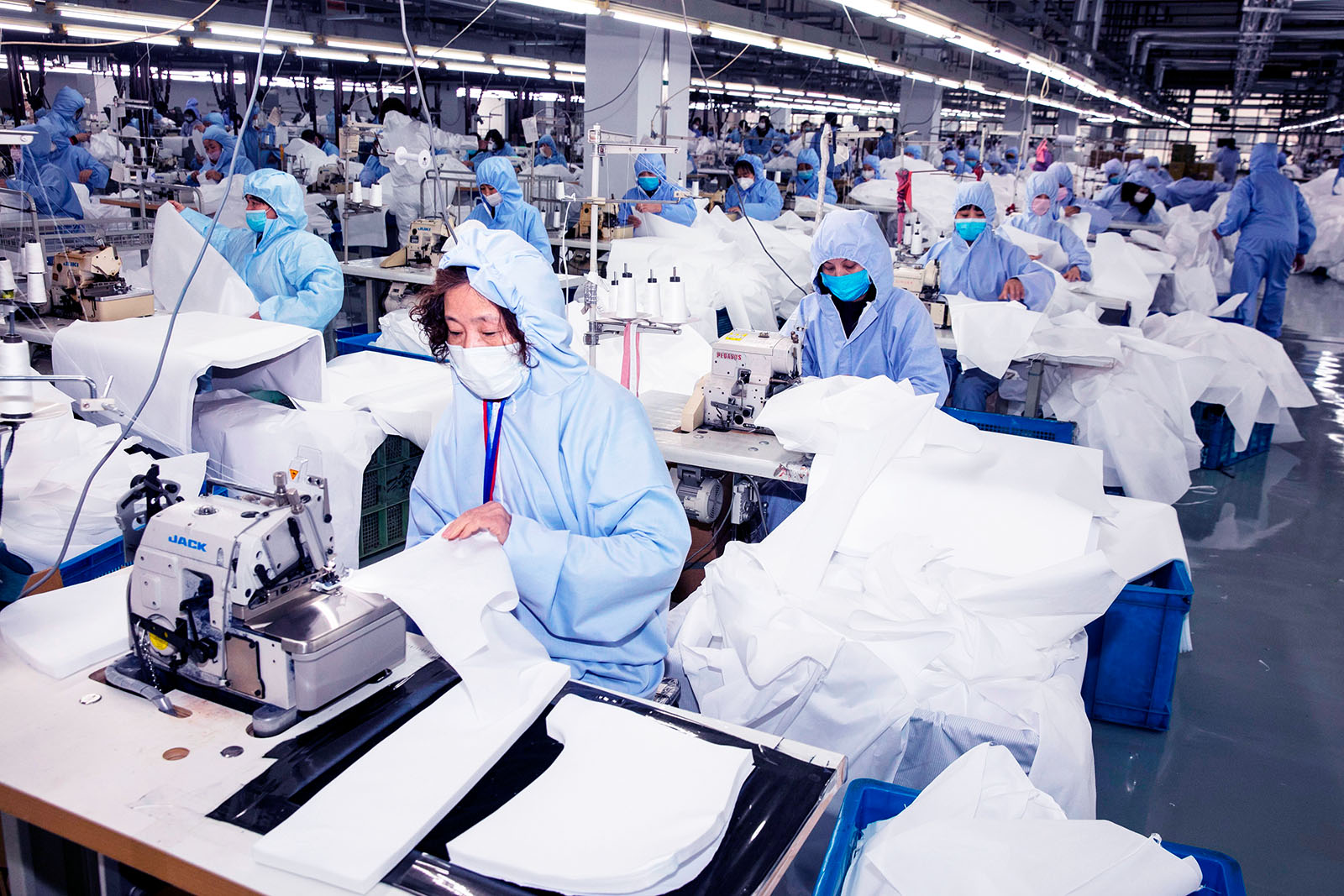Coronavirus Is Rupturing Global Supply Chains

Workers producing protective clothing at a factory in Wuxi, in China's eastern Jiangsu province. The global economic impact of the Chinese COVID-19 outbreak depends on how long the virus lasts, how far it spreads and how much quarantines disrupt the labor market.
Photo: STR/AFP via Getty Images
The coronavirus (COVID-19) outbreak in China will harm the world’s gross domestic product growth since China accounts for 15.4% of global products and services produced. Approximately 500 manufacturing facilities are located in Wuhan, the epicenter of the outbreak, where quarantines are forcing plants to shut down or slow down. Many firms are issuing earnings warnings, and major banks are predicting that both China’s GDP growth and global GDP growth will slow in 2020.
This is in large part because of China’s major role in the global supply chain.
In the Wuhan area, the focus is on producing parts for technology and consumer-electronics products, apparel and textiles, as well as steel and alloys. The supply chain is so specialized that there often aren’t good alternatives to using Chinese parts. And with transportation restricted to contain the virus, shipments of raw materials into China are severely impeded.
Wuhan’s Yangtze port, for example, which handles 1.5 million containers a year, is only handling shipments deemed essential, which has a trickle-down effect on global trade.
Global shipping at U.S. ports is forecast to decline 12.9% year over year in February and 9.5% in March, according to the Global Port Tracker report. And in South Korea, automakers have shut down plants due to lack of component parts from China, implying that there are no alternative suppliers ready to fill the gap.
Analysis of Potential Losses
The global economic impact of the Chinese COVID-19 outbreak depends on how long the virus lasts, how far it spreads and how much quarantines disrupt the labor market.
Oliver Wyman has estimated how much economic value for the European Union is at risk in three different scenarios.
The first scenario assumes the viral outbreak is more or less contained and under control by the end of February, which would put roughly 2 billion euros ($2.2 billion) of value in the EU at risk.
The second scenario assumes the crisis extends for several months, but the virus remains largely limited to the Wuhan region. Every four weeks, value at risk would total 2.5 billion euros, or 7.5 billion euros for a quarter.
The third scenario considers the possibility of a spread into provinces neighboring Wuhan’s Hubei province, with significantly more people under quarantine or lockdown. That would likely create value at risk for the EU of up to 18.7 billion euros per month.
Manufacturers need to assume the worst and make contingency plans.
Transparency Is a Resiliency Asset
The first step in assessing a response to the virus crisis is to develop a transparent vision into the supply chain, which is not an easy task.
The coronavirus health crisis will surely not be the last disruption of the global supply chain, so it is crucial to develop a transparent vision into the supply chain to prepare for the next crisis.
Cars, for example, have anywhere from 30,000 to 100,000 components; airplanes have up to six million. Handbags manufactured in Vietnam use zippers and other materials from China. With electronic circuitry, any one component can include parts from multiple countries — and from tier 3, 4, or 5 suppliers.
A company’s second step is to check inventory levels to see what kind of buffer it has against shortages of specific supplies or finished products. Given that just-in-time manufacturing is a widely accepted global practice, most companies are not likely to have much of an inventory buffer.
Figuring Out Stock Levels Is Not Easy
Figuring out your inventory levels is not complicated, but figuring out what inventory is upstream in the supply chain is infinitely more complicated. Companies don’t share much data, and each company collects data in its own silo.
Consequently, there’s no full end-to-end transparency on stock levels and operational key performance indicators. But the transparency exercise is a good one to undertake, not just for the immediate situation but for the recurring geopolitical, environmental and weather-related crises that are inevitable.
The third step is to understand the impact on manufacturing based on inventory levels and pipeline.
Determine where your suppliers are located and where their suppliers are located, and assess the viability of logistics and transportation routes. Analyze risk exposure — both the negative impact if parts are not available at all and the probability of a constricted supply for multiple months.
What Are the Countermeasures?
Then you need to develop immediate countermeasures. Should you stop production? Should you half-finish products and add missing components later? What are the cost implications of both approaches?
Are there other suppliers outside of China that you can turn to? If not, how do you prioritize production to take advantage of the inventory you have? How long can you keep production going — and when do you alert your customers that the flow of goods will diminish?
These are all short-term, immediate responses, but they are the beginning of a medium- to long-term strategy for the future. The COVID-19 health crisis will surely not be the last disruption of the global supply chain — another disruption could result from an environmental or natural disaster, or geopolitical jousting and hostile conflicts.
Developing a transparent, X-ray understanding of your extended and complex supply chain today will help protect revenue and avoid unnecessary costs presently — and help in developing a resilient response to the next crisis.






